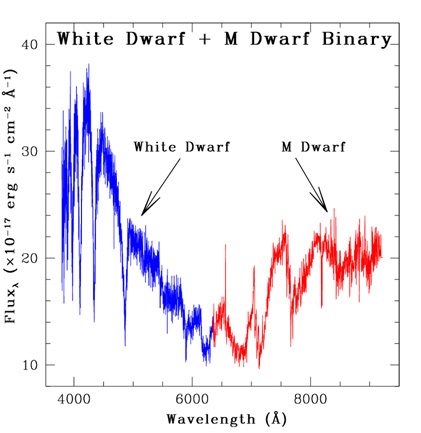
| SDSS Classic |
| SDSS.org |
| SDSS4.org |
| SDSS3.org |
| SDSS Data |
| DR17 |
| DR10 |
| DR7 |
| Science |
| Press Releases |
| Education |
| Image Gallery |
| Legacy Survey |
| SEGUE |
| Supernova Survey |
| Collaboration |
| Publications |
| Contact Us |
| Search |

SLOAN DIGITAL SKY SURVEY ASTRONOMERS FIND WEALTH OF NEW EXOTIC STAR PAIRS
CONTACTS:Nicole Silvestri, University of Washington, (206) 543-9487, nms@astro.washington.edu
Suzanne Hawley, University of Washington, (206) 685-2236 slh@astro.washington.edu
Paula Szkody, University of Washington, (206) 543-1988 szkody@astro.washington.edu
Michael A. Strauss, SDSS Scientific Spokesman, (609) 258-3808 strauss@astro.princeton.edu
ATLANTA -- Until recently, astrophysicists studying exotic star systems pairing a white dwarf and a red dwarf in very close proximity didn't have much to go on.
Just five years ago, scientists knew of fewer than 100 such systems, called pre-cataclysmic variables. But today a team of University of Washington astronomers said that, with data from the Sloan Digital Sky Survey (SDSS), the number has now grown to nearly 500.
That is significant because researchers are now able to study white dwarf and red dwarf stars at different stages of their life cycles, giving scientists the ability to compare them and develop an understanding of how the systems evolve and change over the course of billions of years, possibly becoming supernovas.
"We've never had the opportunity to study a variety of these systems in detail before now," said Nicole Silvestri, a University of Washington astronomy researcher. Using this large sample from the SDSS, Silvestri and her colleagues believe they can begin to answer some of the long-standing questions in astronomy about pre-cataclysmic variables and their eventual end products, cataclysmic variable systems.
Silvestri is lead author of a poster presentation on the findings presented today (January 6, 2004) at the American Astronomical Society's annual meeting in Atlanta. Co-authors of the project are Suzanne Hawley and Paula Szkody of the University of Washington's Astronomy Department. The National Science Foundation supported the research.
Pre-cataclysmic variable systems pair a red dwarf star about one-tenth the size of our sun and a dense remnant of a star, called a white dwarf, in close orbit around each other. When the two stars are close enough, orbiting one another in less than four hours, the gravity of the denser white dwarf is able to pull material off of the less dense red dwarf. Material from the red dwarf forms a disk around the white dwarf that eventually accumulates on the surface of the white dwarf. (Variability refers to the changing amount of light coming from the stars as they orbit each other).

|
SDSS scientists recognize white-dwarf/red dwarf pairs by their spectrum, the decomposition of the light into its component wavelengths. This figure shows the spectrum of such a pair; the blue part of the spectrum on the left (smaller wavelengths) is dominated by the white dwarf, while the red part on the right (longer wavelengths) is dominated by the red dwarf (also known as an M dwarf). The result is a composite spectrum that doesn't look like the spectrum of any single star. The two stars are close enough to each other that they appear as a single unresolved point of light in a telescope; it is only through the spectrum that the presence of two stars is revealed. (SOURCE: University of Washington, SDSS). |
Pre-cataclysmic variables found so far in the SDSS data have orbital periods of between four and 12 hours and are not close enough to have begun transferring material between the stars.
Silvestri said the evolution of a pre-cataclysmic variable to a cataclysmic variable takes billions of years and studying just one system as it evolves would be impossible. But with nearly 500 pre-cataclysmic variables to study, "A dataset of this size will allow us to take snapshots in time of the evolution of the system," she said. "This will allow the researchers to study how properties of each star change as the pair draw closer to each other, something that until now, has never been investigated."
Silvestri and her colleagues are still at a loss to explain one oddity in the research. Thousands of isolated white dwarfs have been observed and hundreds of them have been found to be magnetic. And many white dwarfs in cataclysmic variables are magnetic. But not one of the white dwarfs observed in the pre-cataclysmic variable systems is magnetic.
"This makes the origin of magnetic cataclysmic variables (known as polars), which do contain magnetic white dwarfs, exceedingly mysterious," added SDSS researcher Suzanne Hawley of the University of Washington.
"That's a question we're still trying to find an answer to," Silvestri said. "How do you get a magnetic white dwarf in a cataclysmic variable if it doesn't originate in one of these pairs that is evolving toward being a cataclysmic variable?" The University of Washington team, James Liebert of the University of Arizona and others are preparing a paper on that finding for the Astronomical Journal.
AUTHORS:
Nicole Silvestri, University of Washington, Astronomy Department, Seattle WA 98195-1580
Suzanne Hawley, University of Washington
Paula Szkody, University of Washington